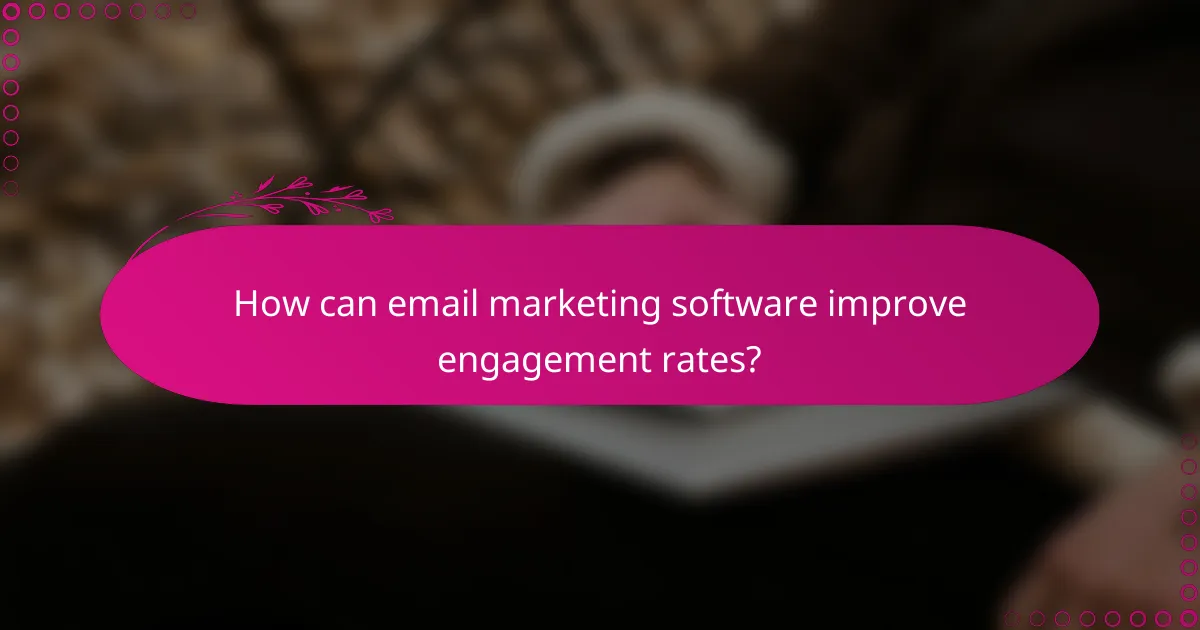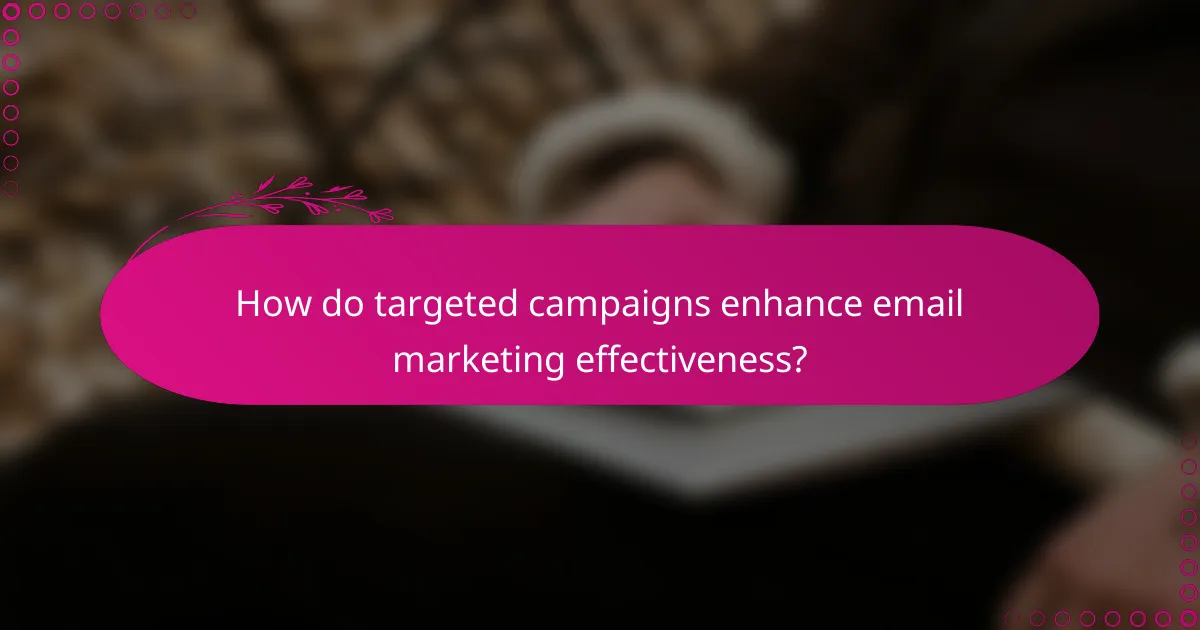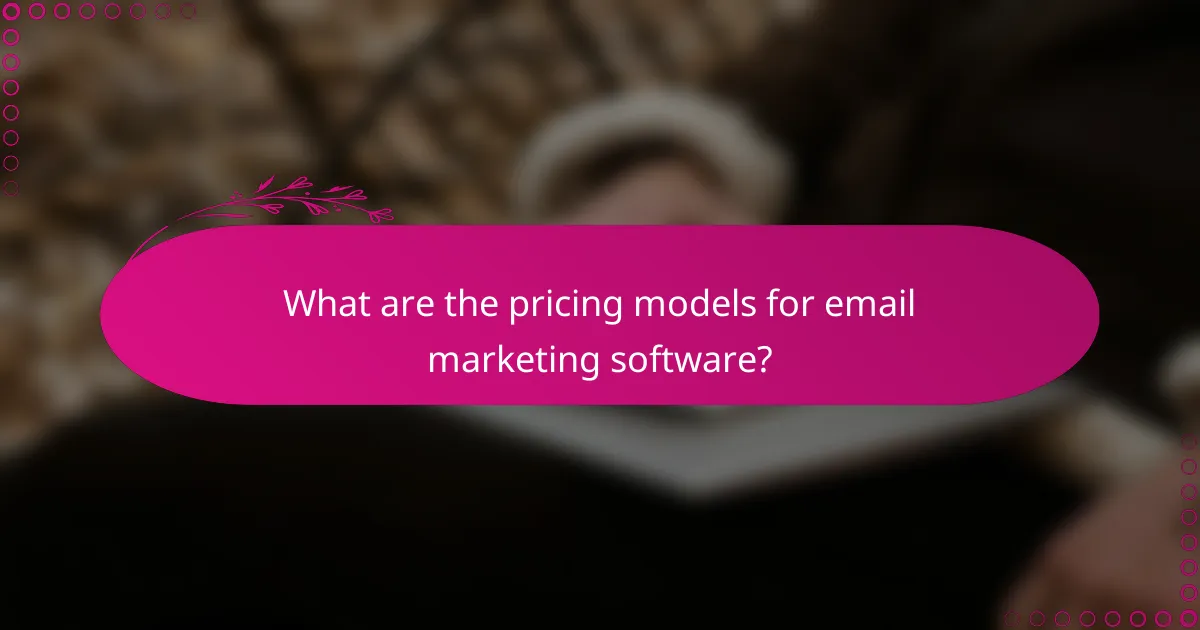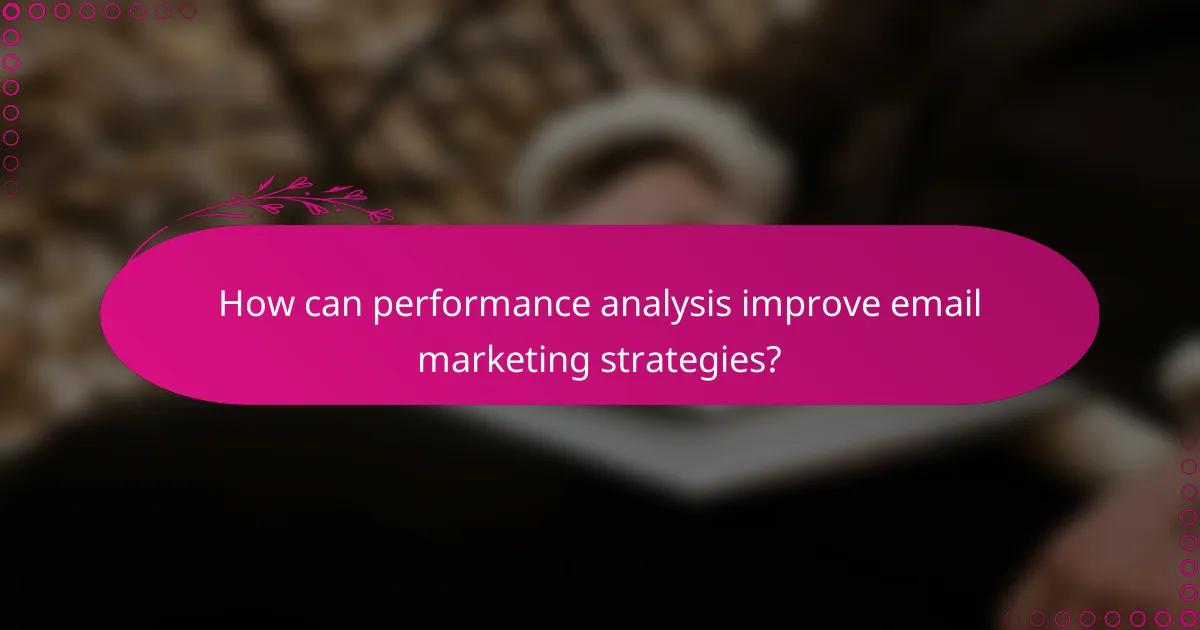Email marketing software plays a crucial role in improving engagement rates through personalized communication and targeted campaigns. By leveraging advanced features such as automation workflows and performance analysis, businesses can effectively tailor their messages to specific audience segments, resulting in higher open and click-through rates. Selecting the right software is essential for optimizing marketing efforts and achieving measurable results.

What are the best email marketing software options in Australia?
In Australia, several email marketing software options stand out for their features, usability, and effectiveness in driving engagement. The best choices offer tools for targeted campaigns, performance analysis, and user-friendly interfaces to enhance marketing efforts.
Mailchimp
Mailchimp is a popular choice for businesses of all sizes, known for its intuitive design and robust features. It offers a free tier for smaller lists, making it accessible for startups and small businesses.
Key features include customizable templates, automation workflows, and detailed analytics. Users can segment their audience for targeted campaigns, which can significantly improve engagement rates.
Campaign Monitor
Campaign Monitor is tailored for businesses looking for visually appealing email designs and advanced analytics. It provides a drag-and-drop email builder that simplifies the creation of professional-looking campaigns.
This platform excels in personalization options, allowing marketers to tailor messages based on user behavior. Its reporting tools help track performance metrics, making it easier to refine strategies over time.
ActiveCampaign
ActiveCampaign is known for its powerful automation capabilities and CRM integration. It is ideal for businesses that want to combine email marketing with customer relationship management.
The software allows for complex automation sequences, enabling targeted messaging based on user interactions. This can lead to higher conversion rates, especially for e-commerce businesses.
Sendinblue
Sendinblue offers a comprehensive suite of marketing tools, including email marketing, SMS campaigns, and chat features. Its pricing model is based on the number of emails sent rather than the number of contacts, which can be cost-effective for larger lists.
With features like A/B testing and advanced segmentation, Sendinblue helps marketers optimize their campaigns for better results. The platform is particularly useful for businesses looking to integrate multiple communication channels.
GetResponse
GetResponse is a versatile email marketing platform that includes features for webinars and landing pages, making it suitable for a variety of marketing strategies. It offers a user-friendly interface with a range of templates to choose from.
The platform’s automation tools allow users to create personalized customer journeys, enhancing engagement. GetResponse also provides comprehensive analytics to track campaign performance, helping businesses make data-driven decisions.

How can email marketing software improve engagement rates?
Email marketing software enhances engagement rates by enabling personalized communication, targeted campaigns, and performance analysis. These tools help businesses tailor their messages to specific audience segments, leading to higher open and click-through rates.
Personalization features
Personalization features allow marketers to customize emails based on subscriber data, such as name, location, and past behavior. This approach makes recipients feel valued and increases the likelihood of engagement. For example, addressing a subscriber by their first name can boost open rates significantly.
Moreover, dynamic content can change within the email based on user preferences or demographics. This means that different segments of your audience can receive tailored messages, enhancing relevance and connection.
A/B testing capabilities
A/B testing capabilities enable marketers to compare two versions of an email to determine which performs better. By testing elements like subject lines, images, or call-to-action buttons, businesses can optimize their campaigns for maximum engagement. A/B tests typically require a sample size that allows for statistically significant results.
It’s advisable to test one variable at a time to accurately assess its impact. For instance, changing the subject line alone while keeping the content the same can provide clear insights into what resonates with your audience.
Segmentation tools
Segmentation tools allow businesses to divide their email list into smaller groups based on specific criteria, such as demographics, purchase history, or engagement levels. This targeted approach ensures that the right message reaches the right audience, leading to improved engagement rates.
Effective segmentation can involve creating categories like new subscribers, loyal customers, or inactive users. Tailoring content to these groups can significantly enhance the effectiveness of email campaigns, as each segment receives information that is relevant to their interests and behaviors.

What are the key features to look for in email marketing software?
When selecting email marketing software, focus on features that enhance engagement rates, enable targeted campaigns, and provide robust performance analysis. Key functionalities include automation workflows, analytics and reporting, and integration with CRM systems, which collectively help optimize your email marketing efforts.
Automation workflows
Automation workflows allow you to create sequences of emails triggered by specific actions, such as sign-ups or purchases. This feature helps in sending timely messages that resonate with your audience, leading to improved engagement rates. For example, a welcome series can be set up to nurture new subscribers automatically.
Consider the complexity of the workflows you need. Some software offers simple automation, while others provide advanced options like conditional logic. Choose a platform that aligns with your marketing strategy and allows for easy modifications as your needs evolve.
Analytics and reporting
Analytics and reporting tools are essential for measuring the effectiveness of your email campaigns. Look for software that provides insights into open rates, click-through rates, and conversion rates. These metrics help you understand how well your emails perform and where improvements are needed.
Effective reporting should also allow for A/B testing, enabling you to compare different subject lines or content formats. This iterative approach can significantly enhance your campaigns over time. Aim for software that offers customizable reports to suit your specific goals.
Integration with CRM systems
Integration with Customer Relationship Management (CRM) systems is crucial for maintaining a cohesive marketing strategy. This feature allows you to sync customer data, ensuring your email campaigns are informed by the latest interactions and preferences. A well-integrated system can enhance targeting and personalization.
When selecting software, verify compatibility with your existing CRM. Popular platforms often offer native integrations or APIs for seamless data transfer. This connectivity can save time and reduce errors, ultimately leading to more effective campaigns.

How do targeted campaigns enhance email marketing effectiveness?
Targeted campaigns significantly improve email marketing effectiveness by delivering personalized content to specific audience segments, resulting in higher engagement rates. By focusing on the unique preferences and behaviors of different groups, marketers can craft messages that resonate more deeply with recipients.
Audience segmentation
Audience segmentation involves dividing your email list into smaller groups based on shared characteristics such as demographics, purchase history, or engagement levels. This allows marketers to tailor their messages to meet the specific needs and interests of each segment, leading to improved open and click-through rates.
For example, a clothing retailer might segment their audience into categories like men, women, and children, sending targeted promotions that reflect the preferences of each group. Using segmentation can increase engagement by up to 50%, making it a crucial strategy for successful email marketing.
Behavioral triggers
Behavioral triggers are automated emails sent in response to specific actions taken by users, such as abandoning a shopping cart or signing up for a newsletter. These timely messages can effectively re-engage potential customers and encourage them to complete desired actions.
For instance, if a customer leaves items in their cart without completing the purchase, a triggered email reminding them of their abandoned cart can prompt them to finalize the transaction. Implementing behavioral triggers can lead to conversion rates that are significantly higher than standard email campaigns, often exceeding 20% in some cases.

What are the pricing models for email marketing software?
Email marketing software typically offers various pricing models to accommodate different business needs and budgets. The most common models include monthly subscription plans and pay-as-you-go options, each with its own advantages and considerations.
Monthly subscription plans
Monthly subscription plans charge a fixed fee each month, providing access to a suite of features based on the selected tier. These plans often include benefits like unlimited emails, advanced analytics, and customer support, making them suitable for businesses with consistent email marketing needs.
When choosing a subscription plan, consider the number of contacts you have and the frequency of your campaigns. Prices can range from around $10 to several hundred dollars per month, depending on the provider and the features included. Look for plans that offer scalability as your business grows.
Pay-as-you-go options
Pay-as-you-go options allow businesses to purchase credits or packages of emails, paying only for what they use. This model is ideal for companies with sporadic email marketing needs or those just starting out, as it avoids the commitment of a monthly fee.
Costs for pay-as-you-go services can vary widely, often starting at around $0.01 to $0.10 per email sent. This flexibility can be beneficial for managing budgets, but be mindful of potential higher costs if you send larger volumes of emails frequently. Always compare the total cost of ownership with subscription plans to determine the best fit for your strategy.

How can performance analysis improve email marketing strategies?
Performance analysis enhances email marketing strategies by providing insights into engagement metrics, allowing marketers to refine their campaigns. By examining open rates, click-through rates, and conversion data, businesses can tailor their messaging and targeting for better results.
Understanding key performance indicators (KPIs)
Key performance indicators (KPIs) are essential metrics that help evaluate the success of email marketing campaigns. Common KPIs include open rates, click-through rates, bounce rates, and conversion rates. Monitoring these indicators allows marketers to identify trends and areas for improvement.
For instance, a low open rate may suggest that subject lines need to be more compelling, while a high bounce rate could indicate issues with the email list quality. Regularly reviewing these KPIs helps in making informed decisions about future campaigns.
Utilizing A/B testing for optimization
A/B testing, or split testing, involves sending different versions of an email to segments of your audience to determine which performs better. This method allows marketers to experiment with various elements, such as subject lines, content, and call-to-action buttons, to see what resonates most with recipients.
For example, if one subject line leads to a significantly higher open rate than another, marketers can adopt that approach in future campaigns. A/B testing should be conducted regularly to continuously refine strategies based on audience preferences.
Segmenting your audience for targeted campaigns
Segmenting your audience involves dividing your email list into smaller groups based on specific criteria, such as demographics, purchase history, or engagement levels. This targeted approach allows for more personalized messaging, which can lead to higher engagement rates.
For instance, sending tailored offers to frequent buyers can increase conversion rates, while re-engagement campaigns can be directed at inactive subscribers. Effective segmentation ensures that the right message reaches the right audience at the right time.
Implementing feedback loops for continuous improvement
Feedback loops involve collecting data and insights from your audience to inform future email marketing strategies. This can include surveys, direct responses, or analyzing engagement patterns. By understanding what your audience values, you can adjust your content and approach accordingly.
For example, if subscribers express a preference for certain types of content, such as promotions or educational material, you can prioritize those in your campaigns. Establishing a feedback loop fosters a responsive marketing strategy that evolves with audience needs.
